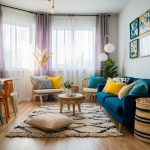Designing Multifunctional Spaces: Tips for Any Room
Creating a multifunctional space involves a blend of creativity and practicality, essential for maximizing the potential of any room. By incorporating versatile design elements, a single room can accommodate multiple activities without sacrificing style or comfort. Investing in furniture that serves dual purposes, like a sofa bed or an extendable dining table, can transform a limited area into a dynamic living space.
Integrating smart storage solutions helps maintain tidiness while ensuring every item has its place. Wall-mounted shelving, under-bed drawers, and hidden compartments in furniture are excellent ways to make the most of available space. These elements not only enhance functionality but also contribute to a clean and organized environment.
Lighting plays a crucial role in multifunctional design, influencing the room’s mood and usability. Flexible lighting options, such as dimmer switches and layered lighting, offer control over the ambiance. Combining various light sources allows a room to transition smoothly from a bright, vibrant meeting spot to a cozy relaxation area.
Understanding Multifunctional Spaces
Multifunctional spaces are designed to perform multiple functions within a single area. Adaptability plays a crucial role, allowing spaces to seamlessly transition between different uses.
Defining Multifunctional Design
Multifunctional design refers to creating spaces that serve multiple purposes, often by incorporating versatile furniture and clever layouts. These rooms maximize utility without compromising on aesthetics. For instance, a living room might double as a home office by including a fold-out desk. The key is in the strategic use of items that can multitask, such as a sofa bed for both seating and sleeping areas. This approach is especially beneficial in smaller homes, where space is at a premium. By integrating multifunctional elements, residents can enjoy a range of activities in one cohesive space, streamlining daily life.
The Role of Adaptability in Spaces
Adaptability is essential in designing spaces that can change in function as needed. Flexible furniture, like modular sofas or extendable tables, allows rooms to be reconfigured for different activities. Homeowners can easily switch from a family gathering area to a quiet reading nook with minimal effort. This adaptability not only maximizes efficiency but also ensures that the space remains relevant as needs change. For example, as a family grows, a room once meant for a play area might transform into a study zone. By planning for adaptability, spaces can evolve over time, meeting the dynamic requirements of their users without extensive redecoration.
Maximizing Space with Clever Furniture Choices
Using furniture that serves multiple purposes can significantly enhance the functionality of any room. Emphasizing both practicality and innovation, these designs create environments that adapt to various needs, whether it’s sleeping arrangements or hidden storage.
Selecting Multi-Functional Furniture
Multi-functional furniture offers flexibility and adaptability in small spaces. Pieces like sofa beds or extendable dining tables transition seamlessly between different uses, providing both comfort and convenience. These designs save space by reducing the need for multiple separate items. Items with hidden compartments, like beds or benches with built-in storage, contribute further by combining storage solutions with everyday furniture. Quality and design should be prioritized to ensure longevity and efficient use of space, making them ideal investments for any home.



